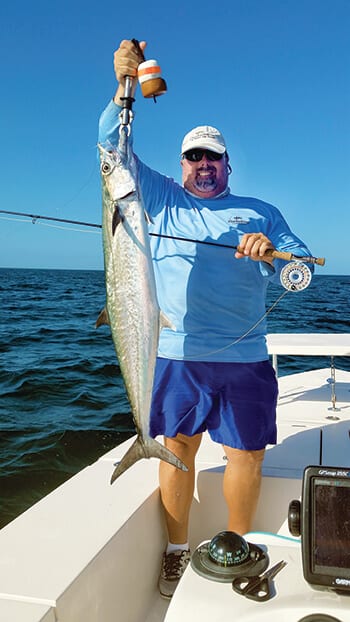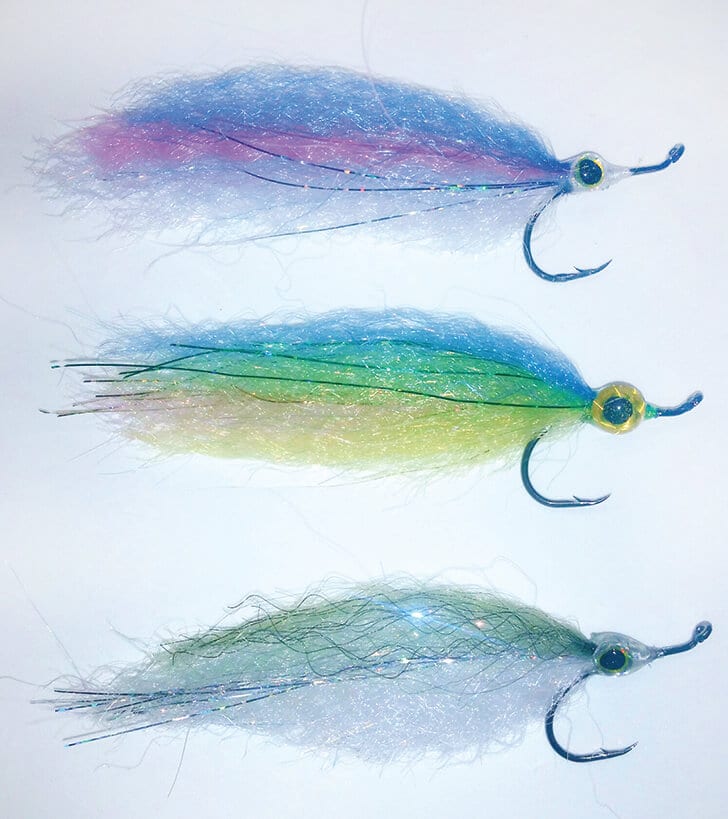By Captain Roan zumFelde:
Kingfish season has come again to southwest Florida waters, and for fly fishers and conventional anglers alike, these super speedsters offer exciting action.
Kingfish are migratory and follow water temperature and baitfish migrations, but they are also structure related. Structure such as wrecks or reefs or just hard bottom areas in the Gulf of Mexico will hold concentrations of baitfish, which in turn congregate the kingfish. This makes them a great target for fly anglers, and if you have ever hooked a 30-lb. king on a 9- or 10-weight fly rod, you will quickly know why they are popular.
You will need to equip yourself with at least an 8-weight fly rod and reel, but no more than a 10-weight. The reel needs to hold a minimum of 200 yards of backing and have a very sound saltwater drag system. When these fish take a fly, the first run can be at blinding speeds. I have seen lesser-quality reels explode under the heat and strain. Also, you never know what other creatures are lurking with kingfish, especially if you are on some type of a wreck structure. We have caught false albacore, sharks and amberjack, along with other species.
I recommend either an intermediate sinking fly line or a 250- to 350-grain sink-tip line. A sturdy fly leader should be about 8 feet long and consist of a 50-lb.-test butt section, 2 to 3 feet of 40-lb. and 2 to 3 feet of 30-lb. You can use a 20-lb. class, but that is up to you. Connect to the class section a foot-long piece of coffee-colored wire, like Malin in size 4 or 5 attached with an Albright knot and a haywire twist to the fly, which rounds out the rig.
Synthetic baitfish flies from 3 to 6 inches on 3/0 to 4/0 size hooks and in various colors can be used. I suggest weighted patterns of the same flies tied on jig hooks to be included in your arsenal.
Now, how do you go about catching these critters? My favorite way is to load up my livewells with frisky pilchards and travel to my secret fishing spot offshore. This can be an artificial reef or some type of hard bottom, wreck or just structure that can be as close as a couple miles out and as far as 40 miles. Usually bait and tackle shops are good sources of where the highest concentrations of fish are. I like to power drift with my trolling motor down so I can control my speed over my target spot. Starting up-wind makes it is easier to cast as I cross over the area pitching stunned pilchards to hopefully send silver rockets skying out of the water.
Make long casts, letting the fly settle a bit and use a somewhat slow retrieve, pausing occasionally. Strip the fly all the way back to the boat, because on many occasions I’ve had fish take right at the boat. If nothing happens on the first drift, change the angle of the drift and try again. Sometimes fish will hold off one side of the structure or the other.
Contact Capt. Roan z. at Mike’s Bait House on Danford Street in Naples. Phone: (239)-775-2248 or cell: (239)-269-4426. See www.indianpassoutfitters.com and www.mikesbaithouse.com.


